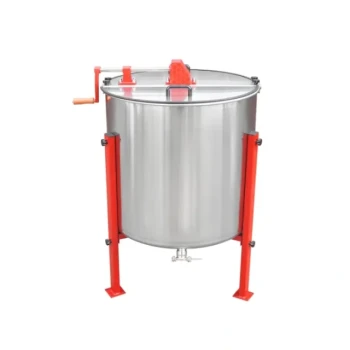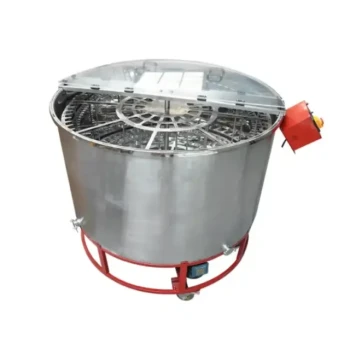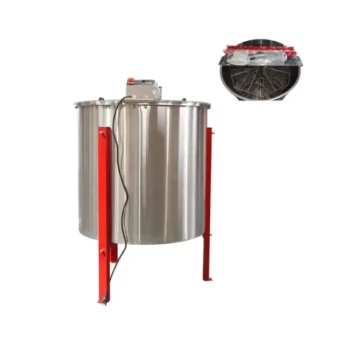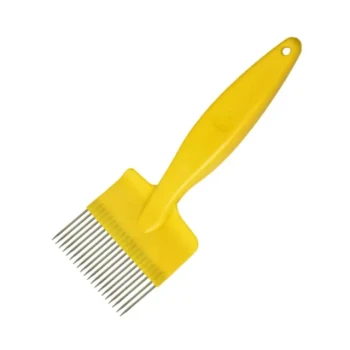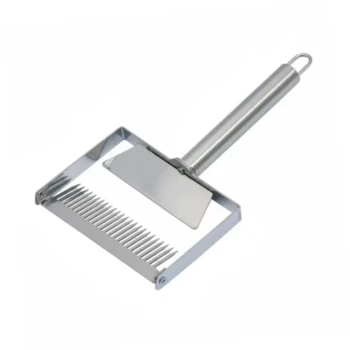In essence, the pressing method for extracting honey involves physically crushing the honeycomb and squeezing the honey out. Often called the "crush-and-strain" method, it is a low-tech approach that forces honey from the comb, which is then strained to separate the liquid honey from the wax debris.
While pressing is the simplest, lowest-cost way to extract honey, it comes with a significant trade-off: it permanently destroys the honeycomb. This forces your bees to expend valuable time and energy rebuilding the comb instead of producing more honey.

The Pressing (Crush-and-Strain) Method Explained
This method is the most ancient and straightforward way to harvest liquid honey. It can be done with basic kitchen equipment or a specialized honey press.
Step 1: Prepare the Frames
Before you can press the honey, you must remove the wax cappings that seal the cells. This is typically done with a heated uncapping knife or a simple fork, which slices or scrapes off the thin top layer of wax.
Step 2: Crush the Comb
Once uncapped, the entire honeycomb is cut from the frame. The pieces of comb are then placed into a strong, porous bag, such as one made of calico cloth or a specialized nylon straining bag.
The comb inside the bag is then thoroughly crushed by hand or with a tool. This breaks open all the wax cells, releasing the honey.
Step 3: Press and Separate
The honey is forced out of the bag by squeezing, twisting, or using a mechanical press. The liquid honey passes through the filter bag, leaving the crushed wax behind.
This process is inherently sticky and can be labor-intensive, but it is effective at separating the bulk of the honey from the wax.
Step 4: Strain and Settle
The collected honey will still contain fine particles of wax and other debris. It must be passed through a finer strainer or a series of progressively finer sieves to achieve a clean final product.
Allowing the honey to sit in a covered container for a day or two will also let the last remaining tiny air bubbles and wax particles rise to the surface, where they can be skimmed off.
Understanding the Trade-offs
Choosing an extraction method requires weighing the benefits against the drawbacks. The pressing method presents a clear choice between cost and efficiency.
The Primary Advantage: Low Cost and Simplicity
The key appeal of the crush-and-strain method is its accessibility. It requires no significant financial investment in specialized equipment like a centrifugal extractor, making it ideal for new beekeepers or those with only one or two hives.
The Major Disadvantage: Destruction of Comb
This is the most critical factor to consider. Bees expend a tremendous amount of energy to produce wax and construct honeycomb. It is estimated that bees consume 6-8 pounds of honey to produce just one pound of wax.
By destroying the comb, you force the colony to rebuild it from scratch. This significantly reduces the amount of honey they can store in the next harvest, as their energy is diverted from foraging to wax production.
How Pressing Compares to Centrifugal Extraction
The main alternative to pressing is using a honey extractor, which works on the principle of centrifugal force.
The Goal of Centrifugal Extraction
In this method, uncapped frames are placed inside a drum (the extractor) and spun at high speed. The force slings the honey out of the cells and onto the wall of the drum, where it drains to the bottom.
The Equipment and Comb Preservation
The crucial difference is that centrifugal extraction does not damage the comb. The empty frames can be returned directly to the hive for the bees to refill. This saves the bees immense energy and leads to higher honey yields over time. However, extractors represent a significant upfront cost.
Making the Right Choice for Your Goal
Your decision should be based on the scale of your operation and your long-term beekeeping goals.
- If your primary focus is harvesting from one or two hives with minimal initial investment: The pressing (crush-and-strain) method is a perfectly viable and effective starting point.
- If your primary focus is maximizing honey production and supporting long-term hive productivity: Investing in a centrifugal extractor is the superior choice because it preserves the bees' valuable honeycomb.
Understanding this fundamental trade-off between upfront cost and comb preservation is the key to choosing the right extraction path for your beekeeping journey.
Summary Table:
| Aspect | Pressing (Crush-and-Strain) | Centrifugal Extraction |
|---|---|---|
| Process | Crush comb; press honey out | Spin frames; honey is slung out |
| Comb Outcome | Comb is destroyed | Comb is preserved for reuse |
| Best For | 1-2 hives; minimal investment | Maximizing long-term honey yields |
| Key Trade-off | Low upfront cost | Higher upfront cost, saves bee energy |
Ready to scale your honey production and preserve your bees' energy?
For commercial apiaries and beekeeping equipment distributors, the right extraction equipment is key to maximizing efficiency and honey yields. HONESTBEE supplies durable, high-performance centrifugal extractors and other essential beekeeping supplies through our wholesale-focused operations.
Contact our team today to discuss your equipment needs and unlock greater productivity for your operation.
Visual Guide
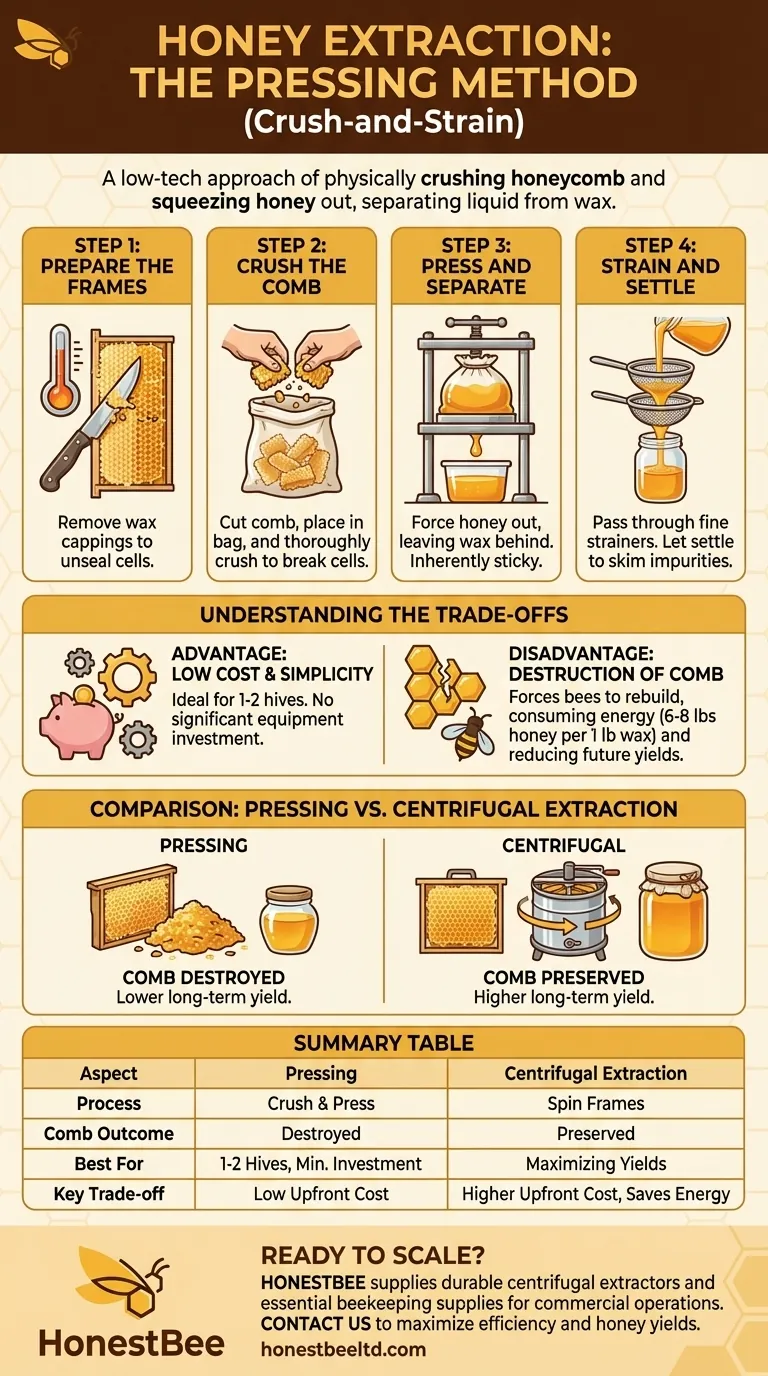
Related Products
- HONESTBEE 3-Frame Manual Acrylic Honey Extractor
- Plastic Hand Crank 2 Frame Honey Extractor Low Price
- 6 Frame Manual Stainless Steel Honey Extractor Beekeeping Equipment
- Stainless Steel 3 Frame Manual Honey Extractor Spinner for Bee Honey Extraction
- electric honey extractor honey centrifuge 3 frame honey extractor stainless steel honey frame extractor
People Also Ask
- How do you manually extract honey? Choose the Best Method for Your Hive
- How often do beekeepers collect honey? Maximize Your Hive's Sustainable Yield
- What machines are needed in beekeeping besides basic tools? Scale Your Honey Harvest Efficiently
- What equipment is used for honey harvest? Essential Tools for Every Beekeeper
- Which type of honey extractor is generally more durable? Focus on Material & Build Quality for Longevity


